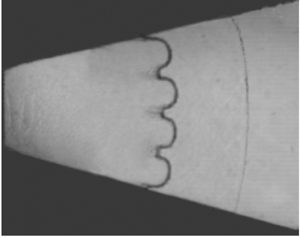Article contents
On divergent Richtmyer–Meshkov instability of a light/heavy interface
Published online by Cambridge University Press: 02 September 2020
Abstract

We report the first experiments on divergent shock-driven Richtmyer–Meshkov instability (RMI) at well-controlled single-mode interfaces. These experiments are performed in a novel divergent shock tube designed by shock dynamics theory. Generally, the perturbation growth can be divided into three successive stages: linear growth, quick reduction in growth rate and instability freeze-out. It is observed that the growth rate at each stage is far lower than its counterpart in planar or convergent geometry due to geometric divergence. We also found that nonlinearity is much weaker than that in planar or convergent RMI, and has a negligible influence on the overall amplitude growth even at late stages when it has become strong. This weak nonlinear effect is because the growth of the third harmonic counteracts its feedback to the fundamental mode. As a consequence, the linear theory of Bell (report no. LA-1321) accounting for geometric divergence and Rayleigh–Taylor (RT) stabilization caused by flow deceleration can reasonably predict the present results from early to late stages. The instability freeze-out at late times is ascribed to the negative growth induced by geometric divergence and RT stabilization, and is also well reproduced by the linear theory.
- Type
- JFM Papers
- Information
- Copyright
- © The Author(s), 2020. Published by Cambridge University Press
References
REFERENCES
- 13
- Cited by





